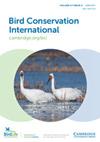Local population decline of the threatened Lesser Grey Shrike Lanius minor is linked to the modernisation of the rural landscape
IF 1.5
4区 环境科学与生态学
Q3 BIODIVERSITY CONSERVATION
引用次数: 0
Abstract
Summary Landscape changes and the intensification of agriculture in recent centuries were largely responsible for the dramatic decline in the biodiversity of farmlands. Rural settlements have also been subject to radical changes due to modernisation, but their impact on bird populations is poorly quantified. The Lesser Grey Shrike受威胁的小灰鵙(Lanius minor)在当地的数量减少与农村景观的现代化有关
摘要 近几个世纪以来的景观变化和农业集约化在很大程度上导致了农田生物多样性的急剧下降。农村住区也因现代化而发生了翻天覆地的变化,但这些变化对鸟类种群的影响却很少被量化。小灰鵙(Lanius minor)是一种濒临灭绝的农田鸟类,在许多地区已经灭绝。我们在三个繁殖季节(1996 年、2016 年和 2021 年)监测了波良纳山脉(斯洛伐克中部)传统农耕区的这一长途迁徙鸟类种群。我们分析了现代居住区数量增加和传统农庄减少对种群数量下降的影响。繁殖地的数量从 1996 年的 73 个减少到 2016 年的 38 个和 2021 年的 22 个。随着种群数量的减少,繁殖区域也大幅缩小。1996 年,繁殖地内没有现代住宅,而到 2021 年,现代住宅的数量已增加到传统农庄的数量。在一个领地内建造一座现代房屋会将筑巢概率降低到约 6%,当仍有一个或两个农场时也会出现这种效果(分别为 17% 和 40%)。在领地内再建一座现代住宅,筑巢概率几乎会降至零,即使当时已有一座农庄。在这项长期的实证研究中,我们发现这些变化对所研究的物种来说是当地的一个威胁因素。研究结果有助于在传统农耕景观中设计和实施保护措施。
本文章由计算机程序翻译,如有差异,请以英文原文为准。
求助全文
约1分钟内获得全文
求助全文
来源期刊
CiteScore
3.40
自引率
6.20%
发文量
50
审稿时长
>12 weeks
期刊介绍:
Bird Conservation International is a quarterly peer-reviewed journal that seeks to promote worldwide research and action for the conservation of birds and the habitats upon which they depend. The official journal of BirdLife International, it provides stimulating, international and up-to-date coverage of a broad range of conservation topics, using birds to illuminate wider issues of biodiversity, conservation and sustainable resource use. It publishes original papers and reviews, including targeted articles and recommendations by leading experts.

 求助内容:
求助内容: 应助结果提醒方式:
应助结果提醒方式:


